Don't wanna be here? Send us removal request.
Text
Google Unveils Next-Gen AI Models for Video and Image Generation
Google Stakes Its Claim in AI Dominance with Veo 2 and Imagen 3

Google has announced the launch of two groundbreaking AI models: Veo 2 and Imagen 3. These next-generation systems promise to revolutionize video and image generation, delivering unprecedented realism, detail, and creative control. With these releases, Google is solidifying its position as a leader in AI innovation.
Veo 2: Redefining Video Generation

Veo 2 is Google’s latest video generation model, capable of creating high-resolution 8-second clips at 4K resolution (720p at launch). The model boasts significant improvements in cinematic control, physics simulation, and reduced hallucinations, resulting in more natural and lifelike videos. In head-to-head evaluations against competitors like OpenAI’s Sora, Veo 2 emerged as the clear winner for its superior quality and prompt adherence. The model is being rolled out gradually through the VideoFX waitlist, with plans to integrate it into YouTube Shorts by 2025.
Imagen 3: Elevating Image Creation

Imagen 3, Google’s upgraded image generation model, offers enhanced color vibrancy, improved composition, and better handling of fine details, textures, and text rendering. The model’s ability to interpret complex prompts and generate images that match user intentions has also seen significant improvements. In human evaluations, Imagen 3 outperformed leading competitors, including Midjourney and Flux, for its visual quality and prompt adherence. The model is now available through Google Labs’ ImageFX platform, with a global rollout spanning over 100 countries.
The Bigger Picture: Google’s AI Leadership in Focus
Google’s release of Veo 2 and Imagen 3 marks a significant milestone in the AI race. These models demonstrate Google’s commitment to pushing the boundaries of generative AI, delivering state-of-the-art performance in both video and image generation. While OpenAI has dominated headlines this holiday season, Google is showcasing its technical prowess with these cutting-edge tools.
As these models become more widely available, they are poised to reshape the creative landscape, offering users access to powerful AI tools that can transform the way we create and interact with visual content. Google’s latest innovations are a clear signal that the company is not content to sit on the sidelines in the AI arms race—it is doubling down on its investments to set new standards for quality and creativity.
For more news like this: thenextaitool.com/news
0 notes
Text
How A Tiny Caribbean Island Hit The Digital Jackpot with AI
Turning The AI Boom Into A Windfall For Anguilla

The artificial intelligence boom has transformed industries, fueled innovation, and created fortunes for tech giants like Elon Musk’s xAI and Meta’s AI division. But few expected that a small Caribbean island would also cash in on the frenzy. Anguilla, a British overseas territory, has raked in over $32 million thanks to its unique internet domain: “.ai.”
In 1995, Anguilla was assigned the “.ai” country code by ICANN, the organization responsible for managing internet domain names. Fast forward to today, and the island is reaping the benefits as companies scramble to secure “.ai” domains to establish their presence in the AI space. From Google’s google.ai to Elon Musk’s x.ai, businesses are paying between $150 to $200 register these domains, generating millions in revenue for Anguilla.
This unexpected windfall has become a lifeline for the island, which relies heavily on tourism and offshore banking. The $32 million earned last year accounts for about 20% of the government’s revenue, up from just 5% before the AI boom. The money is being used to fund critical projects, including airport expansion, free healthcare for seniors, and vocational training centers. While the island’s Premier, Ellis Webster, acknowledges the revenue boost, he cautions against relying solely on it, noting the unpredictable nature of trends in the tech world.
As the demand for “.ai” domains continues to soar, Anguilla is partnering with U.S.-based Identity Digital to manage the growing registry. This move aims to improve security, resilience, and accessibility for users worldwide. With over 533,000 “.ai” domains registered so far, the future looks bright for this tiny island, proving that even in the age of AI, luck and location can still play a big role.
For more blogs like this: thenextaitool.com/blog
0 notes
Text
Meta AI Releases Llama 3.3 70B Instruct
Explore Llama 3.3 70B Instruct As It Sets New Standards In AI With Enhanced Reasoning, Multilingual, And Cost-Efficient Features
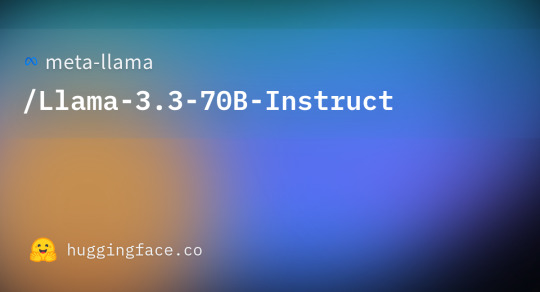
Meta has introduced the Llama 3.3 70B Instruct, an advanced AI model that sets a new benchmark in reasoning, coding, and following instructions. As one of the most adaptable open models available, Llama 3.3 70B brings forth impressive capabilities with a wide array of applications.

Enhanced Functionality and Multilingual Support This model shines in producing structured outputs, especially in step-by-step reasoning and JSON formatting, ensuring reliability and accuracy for developers. With support for eight major languages, including English, French, and Hindi, it aims to facilitate global communication.
Revolutionizing Software Development The improvements in coding encompass extensive language support, better error handling, and comprehensive feedback, enabling developers to enhance their productivity. Llama 3.3’s task-aware tool usage optimizes resource utilization by intelligently activating tools only when needed.
Cost-Effective and Responsible AI Offering performance comparable to larger models like the 405B but at a significantly lower cost, Llama 3.3 makes high-quality AI accessible to more users. It incorporates safety measures such as Llama Guard 3 and Prompt Guard, ensuring secure operations that adhere to ethical AI standards, making it a trustworthy option for sensitive applications.
Real-World Applications From improving education with multilingual assistants to revolutionizing software development processes, the influence of Llama 3.3 is extensive. In business settings, it enhances customer support, refines data analysis, and automates content creation, reinforcing its importance across various industries.
Accessible on platforms like Hugging Face, Llama 3.3 embodies Meta’s commitment to open, responsible, and accessible AI. As generative AI continues to evolve, Meta’s latest development serves as a foundational element for progress and integrity in the field.
For more news like this: thenextaitool.com/news
0 notes
Text
Amazon Introducing New AI Model Family Nova
Amazon's latest foundation models offer cutting-edge intelligence and exceptional price performance in the industry.

Amazon introduced new AI models at the AWS re:Invent conference called Nova. These tools are designed to provide businesses with smarter ways to handle tasks such as understanding and creating content from text, images, and videos. They are part of the Amazon Bedrock library on AWS.
So, what's the deal with these Nova models? Here's a quick rundown:
Nova Micro focuses mainly on text. It is a purely text-based model optimized for performance, providing the fastest responses at the minimum cost.
Nova Lite is a budget multimodal model that excels in quickly handling video, image, and textual inputs.
Nova Pro is highly skilled, offering the best potential across multiple dimensions, including price and accuracy, for a range of tasks.
But wait, there's more! Amazon is also venturing into the content creation space:
Nova Canvas is a sophisticated image creation model.
Nova Reel is the fastest video generation model on the market.
And coming in early 2025, Nova Premier will possess the strongest capabilities of all Amazon’s multimodal models, capable of performing more complex reasoning tasks and serving as the best tutor for distilling custom models.
Amazon isn't stopping there. They are building what might be the largest AI compute cluster ever with the help of Anthropic, using their Trainium 2 chips. Although this sounds technical, it essentially means they are setting the stage for even more powerful AI in the future.
These Nova tools aren't just about adding more technology; they are about transforming how businesses operate in innovative and super-efficient ways. It's Amazon's strategy for staying at the forefront of AI technology, shaping how companies use AI in the future.
That's the update from AWS re:Invent. It will be exciting to see how companies utilize these new tools.
For more news like this: thenextaitool.com/news
0 notes
Text
ChatGPT's Mysterious Block on 'David Mayer' Draws Public Curiosity
Unveiling The Mystery of ChatGPT's Hesitance To Refer To 'David Mayer' And Its Wider Implications For AI Transparency

In a curious twist, ChatGPT, the popular AI chatbot developed by OpenAI -maybe we should say CloseAI- has reportedly been displaying an unusual reluctance to mention the name 'David Mayer'. Users from various online platforms have voiced their concerns, confirming that when prompted with this name, ChatGPT tends to either cut conversations short or misdirect them, offering alternative answers that skirt around the main topic. Despite the growing buzz and speculation, OpenAI has yet to release an official statement explaining this behavior.
The name 'David Mayer' might not ring a bell for everyone, but the context surrounding the mystery reveals links that suggest deeper layers. David de Rothschild, a prominent figure often referred to as David Mayer de Rothschild, is a British adventurer, environmentalist, and film producer. He is notably associated with the illustrious Rothschild family, recognized globally for their legacy in banking and finance.
The gap left by ChatGPT's reticence has prompted many users to ask critical questions about the platform's data handling practices. Is there an intentional block on this name, or is this an anomaly in the AI's data processing system? The incident shines a light on the broader implications of information filtering by AI models. It raises concerns about transparency and the criteria used to censor or redirect certain pieces of information, which are essential aspects of algorithmic accountability.
Speculations about potential external influences aren't going unnoticed either. Some users contend that investor stipulations may have played a role in selecting specific data input filters for ChatGPT. This theory remains unsupported officially, but it highlights an underlying tension between commercial interests and data accessibility in AI technology.
Interestingly, the current situation seems to be inching closer to the 'Streisand effect', wherein attempts to suppress information instead increase its public exposure. Originating from an attempt by singer Barbra Streisand to suppress photos of her residence, this effect underscores the paradoxical nature of trying to censor information in the digital age. The more ChatGPT avoids the topic, the more people seem intrigued, compelling them to delve deeper into why this peculiar censorship might exist.
The incident of "David Mayer" emphasizes a need for transparency around AI restrictions and algorithms guiding censorship decisions. As AI continues to integrate deeply into everyday life, it is crucial that users understand both its capabilities and its limitations. The challenge remains to strike a balance between protecting privacy and ensuring freedom of information, a conundrum that AI developers like OpenAI must navigate carefully. The case underscores the importance of ongoing dialogue about AI ethics and governance in maintaining public trust as technology advances.
For more news like this: thenextaitool.com/news
0 notes
Text
DeepSeek AI Unveils Revolutionary Reasoning Model
China's DeepSeek AI Launches Transparent, High-Performance Model, Signaling a New Era in AI Innovation and Competition

In a significant advancement from China's tech sector, DeepSeek AI has launched the DeepSeek-R1-Lite-Preview, an innovative AI reasoning model set to rival major players like OpenAI. This tool represents a substantial improvement in AI analytical capabilities, especially for tasks that involve complex reasoning and decision-making. By exceeding benchmarks such as AIME and MATH, DeepSeek-R1-Lite-Preview demonstrates its effectiveness and reliability in solving intricate problems.
So, what differentiates DeepSeek? Transparency. Users can observe its reasoning process in real-time, providing clear insights that aid in making informed decisions. Researchers and developers are excited because they anticipate open-source models and an API, which will allow them to integrate DeepSeek’s capabilities into their own projects, fostering numerous opportunities for innovation and collaboration.

Just two months after OpenAI's latest release, DeepSeek AI illustrates that advanced AI algorithms are not exclusive to a handful of leading companies or nations. China's rapid deployment of this technology signals significant shifts in the global AI landscape, serving as a wake-up call for Western countries to enhance their efforts. Improving internet infrastructure and establishing effective AI regulations are essential for them to remain competitive.
Now, consider this: DeepSeek achieved 91.6% on the MATH benchmark, showcasing exceptional performance. Additionally, they plan to adopt an open-source model, which could transform the development and sharing of AI technologies. Currently, users can engage with the R1-Lite version online, and the complete R1 model will soon be available as open-source as well.
DeepSeek originated in quantitative trading and is supported by a talented team with substantial resources, including Math Olympiad gold medalists. With hints of government backing aimed at societal benefits, DeepSeek exemplifies the intersection of private innovation and public goals.
So, what does this mean for everyone? With DeepSeek providing customizable reasoning models, the AI landscape is on the brink of significant transformation. We can anticipate greater accountability and refinement in how AI thinks. The future? A scenario where AI might equal or even exceed human reasoning.
For more news like this: thenextaitool.com/news
0 notes
Text
Best Suno Alternatives for Music Creation in 2024
Discover creative tools that simplify music creation and spark inspiration.

The music industry is going through a significant change with the rise of AI music generators. These innovative tools allow for the creation of unique and engaging musical pieces without needing extensive technical skills.
AI as a creative partner is now a reality, reshaping how we produce and enjoy music. One notable tool in this field is Suno, which is recognized for turning user inputs into beautiful compositions, complete with catchy lyrics and melodies. However, some users have raised concerns about the similarities in the music produced, wishing for more variety and originality. If you find these issues relatable or are simply curious about other options, this blog post will introduce you to some top alternatives.
Udio
Udio allows you to create personalized music tailored to specific moments and experiences in your life.
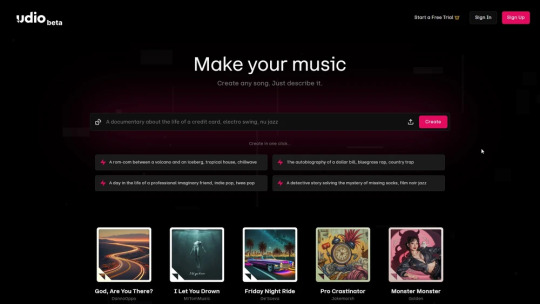
MusicGen
MusicGen by Meta AI generates versatile high-quality music using transformers, processing text or melody, with chromagrams.

Remusic
Remusic is a revolutionary AI tool transforming music creation and enjoyment, signaling the future of AI-generated music.
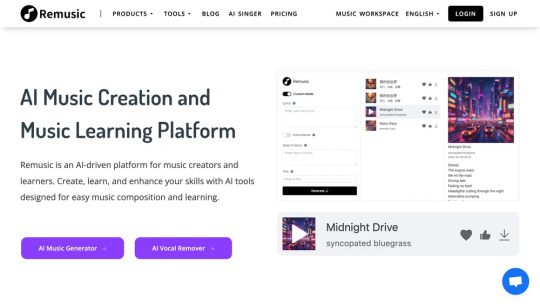
Tad AI
Tad AI provides fast custom royalty-free music generation for musicians, creators, and businesses using AI-generated lyrics and prompts.
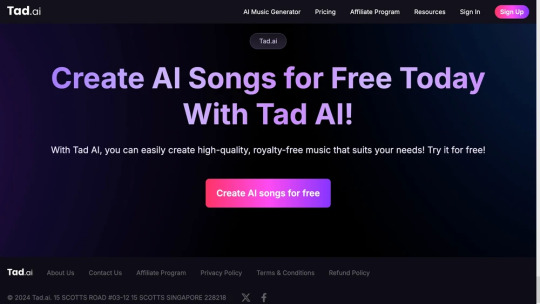
Donna AI
Donna AI transforms ideas into songs, offers royalty-free creations, community sharing, with vocal/instrument isolation.

AI music generators have transformed the way we approach music production, making it more accessible and creative. Whether you're looking to enhance your social media with engaging background music or add a touch of drama to your videos, these tools provide a variety of features to suit your needs. They make music creation more inclusive, allowing for personal expression, with some even available without a subscription, while also helping you avoid potential copyright issues.
As you consider these options, keep in mind that the key is to find a tool that aligns with your creative vision and supports your musical projects.
For more blogs like this: thenextaitool.com/blog
0 notes
Text
ChatGPT for Mac Can Now Work with Apps on Your Desktop
Enhance your coding workflow with ChatGPT's new feature, integrating directly with Xcode, VS Code, and more.
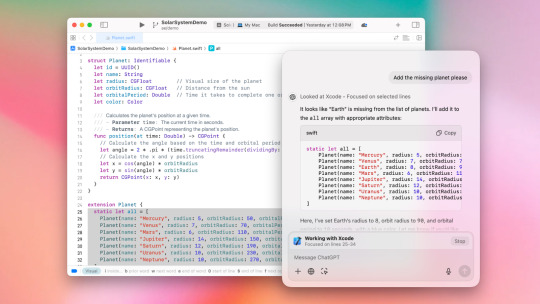
The ChatGPT desktop app for Mac has introduced a new integration feature aimed at enhancing developer productivity by providing direct access to content from popular coding environments such as Xcode, VS Code, and TextEdit. This integration enables ChatGPT to read and utilize context from open files, thereby improving responses with pertinent coding information.
How It Works
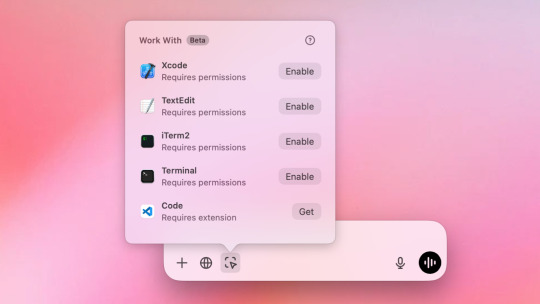
Developers can enable this feature by clicking on “Work With Apps” in the ChatGPT chat bar and selecting a compatible coding application. A banner will show when an app is connected, indicating the types of content that are accessible. For text editors, ChatGPT incorporates the content from the open pane or selected text, while for terminal applications like Terminal and iTerm, it captures the last 200 lines of activity. All accessed information is recorded in the chat history, which users can manage and delete as necessary.
Configuration and Compatibility
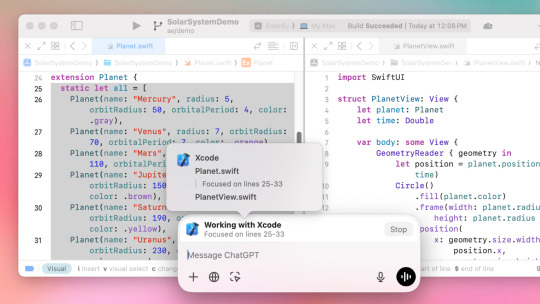
Users can configure this feature under Settings > Work with Apps, allowing them to manage compatible applications and set up the integration. Some applications may require additional steps, such as installing extensions for VS Code.
Privacy and Control
For those concerned about data privacy, users have the option to disable the feature completely. OpenAI highlights the importance of data control: users can prevent their interactions from being used to train the model by adjusting specific settings. The temporary Chat mode ensures that conversations are not saved. OpenAI also assures that enterprise data remains secure and isolated, with no involvement in model training.
This integration represents a significant advancement toward a more seamless, context-aware experience for Mac developers utilizing ChatGPT in their coding tasks.
For more news like this: thenextaitool.com/news
0 notes
Text
Qwen 2.5 Coder Models Launched
Qwen Deliver Flexibility, Performance, and Usability for Developers

The tech world has just welcomed the release of the Qwen 2.5-Coder models, a new series of open-source coding tools that are designed to set a new standard in the world of code LLMs (Large Language Models). Designed with developers in mind, Qwen seeks to improve both the flexibility and capability of open-source coding assistants. The models come in sizes ranging from 0.5B to 32B parameters, addressing a wide array of coding needs and system specifications.
At the high end, the Qwen 2.5-Coder-32B-Instruct model stands out, competing directly with some of the most powerful models available, including GPT-4o, and has achieved state-of-the-art (SOTA) performance in various coding benchmarks. It excels not just in generating code but also in repairing it and reasoning across multiple programming languages, boasting impressive performance scores in languages like Haskell and Racket. These features make it a comprehensive solution for developers looking for both precision and efficiency in their coding tasks.
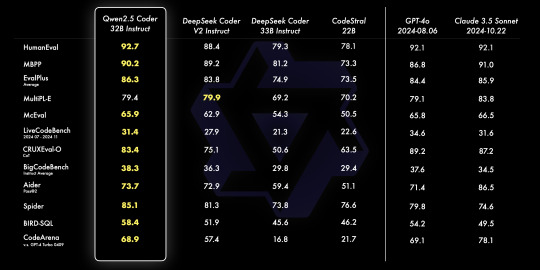
A key highlight of the Qwen launch is its practical application in real-world coding situations. Whether serving as a code assistant or helping with artifact creation, the Qwen offer a new level of usability. For example, code repair becomes much easier due to the model's high scores on benchmarks like Aider, which evaluates its ability to identify and fix code errors. Additionally, Qwen streamlines multi-language tasks, enabling users to adapt code across more than 40 languages without needing extensive knowledge of each one.
To make these models as developer-friendly as possible, the team behind Qwen has put a strong emphasis on aligning with human preferences. By utilizing their own Code Arena benchmark, they fine-tuned the models to enhance human readability and maintain consistent coding styles, resulting in a tool that is both functional and enjoyable to use. With Qwen, developers gain access to a highly refined coding assistant that adapts seamlessly to various coding practices, making it an excellent choice for both collaborative and individual projects.
In summary, Qwen marks a significant advancement in the open-source code model landscape. It offers unparalleled diversity in model sizes, state-of-the-art performance across coding tasks, and a focus on real-world usability, making it an essential tool for modern developers. Whether you're tackling a small project or managing a large codebase, there's a Qwen ready to assist you at every turn.
For more news like this: thenextaitool.com/news
0 notes
Text
AIRIS Takes AI Gaming to New Heights with Minecraft
Discover how AIRIS is transforming AI in gaming by mastering Minecraft’s 3D world, with potential beyond just play.

Now, why is this a big deal? Well, most AIs before focused on flat, 2D stuff. But AIRIS is jumping into Minecraft's 3D world. Think about it. Minecraft is huge and full of surprises. It's the perfect playground for testing AI's skills in understanding and moving through space. The real test here? Can AIRIS figure out Minecraft’s goals without anyone giving it hints? Both scientists and game makers are excited about that one.
You might wonder why they picked Minecraft. Representatives from SingularityNET have a good reason: Minecraft is complicated and super popular. It’s already used in AI learning, so comparing AIRIS to other AIs is easy. Plus, it's a great way to try new ideas.
Here’s How AIRIS Works
It takes in two main things—the layout of the world around it and its place in that world. It can start with basic moves, like jumping or walking. Over time, it’ll learn more, like mining for resources and crafting tools, just like a real Minecraft player.
In "Free Roam" mode, AIRIS explores on its own, building a sort of map in its "head." It learns to handle tricky spots like mountains or caves. That helps it get better at moving around. Pretty neat, right? And if it gets given a specific spot to find, it switches from exploring to finding that spot in no time.
But AIRIS is not just about playing games. It could be a game-changer for developers too. Imagine it helping to spot bugs or test game worlds in titles like Fallout 4. By hanging out with non-playable characters and game elements, it makes finding and fixing problems faster for developers.
In the grand scheme of things, AIRIS isn't just about Minecraft. It’s a big step for AI learning on its own in virtual worlds. The lessons learned here could lead to new breakthroughs, helping AIs tackle more complex real-world challenges. For AI fans, this is huge. GAME on, folks, because AIRIS is paving the way for an intriguing future in AI development.
For more news like this: thenextaitool.com/news
0 notes
Text
7 AI-Powered Photo Editing Alternatives to Photoshop
AI-powered photo editors transform digital imagery by simplifying complex tasks, making sophisticated editing accessible to all.
In the world of digital imagery, capturing the perfect shot is only the beginning; it’s in the post-processing stage where true magic happens, transforming raw photos into stunning, share-worthy visuals. As demand for innovative editing solutions surges, AI-powered photo editors have emerged as essential tools, reshaping the creative process for professionals and casual users alike. From enhancing selfies to crafting high-impact visuals for marketing, AI photo editors are making a notable impact. Let’s explore some of the top AI photo editors redefining the art of image editing.
AI-enhanced photo editing has been quietly revolutionizing the industry for years, with tools like Adobe’s Content Aware Fill in 2010 and Neural Filters in 2020 offering a glimpse into how AI can elevate editing. These features have evolved into powerful tools that streamline complex tasks, from upscaling low-resolution images to replacing dull skies with vivid scenes, making sophisticated editing accessible and intuitive for users of all skill levels.
Adobe Photoshop, a leader in this space, continues to push boundaries with features like the Remove Tool and Generative Expand, which transform image manipulation into a seamless experience. Today’s AI editors leverage machine learning to deliver capabilities like automated subject selection, sky replacement, and mood optimization—simplifying tasks once reserved for seasoned experts. So, which photo edit tools truly stand out? Let’s explore the top contenders reshaping the photo editing landscape.
Pixlr
Pixlr’s AI-driven features are now concentrated within its Pixlr. The AI Cutout and Backdrop replace backgrounds in seconds, while face swap and object removal enhance versatility. Pixlr brings an imaginative touch to quick edits without compromising accuracy.
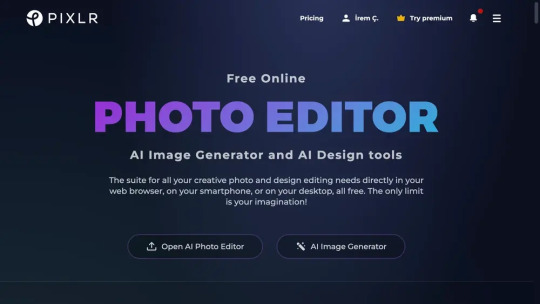
Evoto
Tailored for both novices and seasoned photographers, Evoto offers potent AI capabilities to make portrait retouching seamless and establishes custom presets that effortlessly beautify images with a single click.
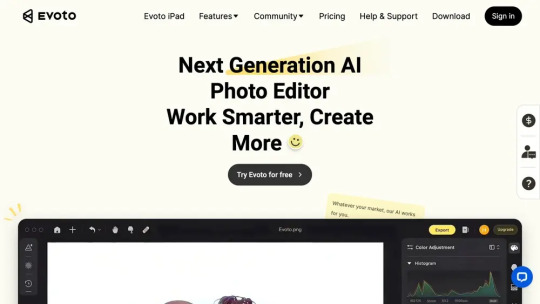
ACDSee
ACDSee merges AI power with user-friendliness in its Photo Studio Ultimate 2025. From RAW photo tweaks to enhanced image management, this software marries simplicity with effectivity, making AI editing both accessible and robust.
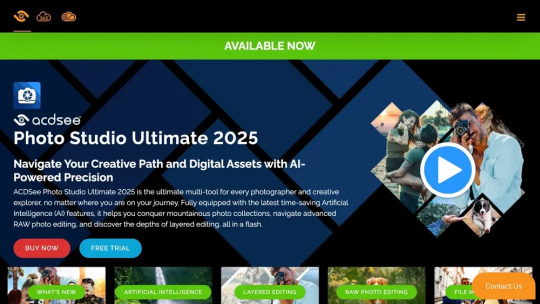
Luminar Neo
This cost-effective alternative stands out with AI-powered adjustments that enhance skies, erase distractions, and adaptively refine images. With deep integration of AI, it enriches images by enhancing tones, colors, and correcting sky imperfections.
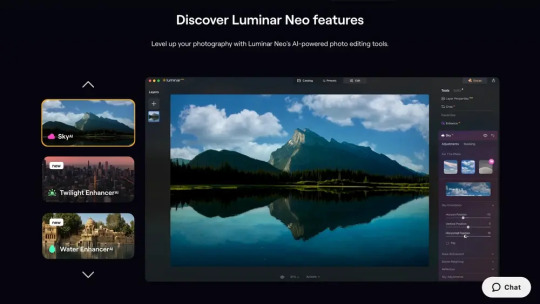
Canva
While not a direct competitor to Photoshop, Canva shines in quick edits and social media graphics. It’s an AI-enhanced powerhouse with smart design tools like Magic Design, BG Remover and Magic Media, simplifying creative processes.
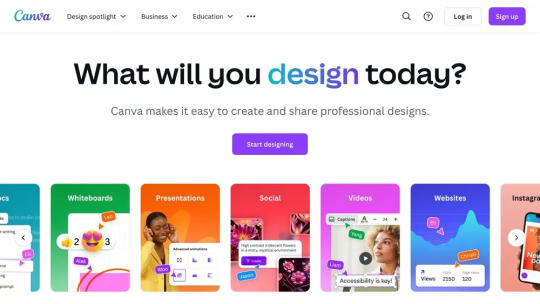
Lensa AI
Renowned for its Magic Avatar fun, Lensa AI also equips users with smartphone-based AI editing prowess. Its Magic AI tool is adept at finetuning portraits for those wanting glam or subtle tune-ups.
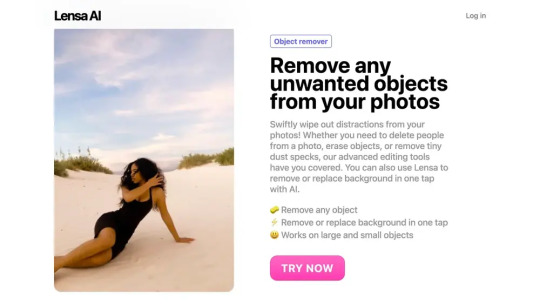
Capture One
Capture One combines AI with superior image quality, emphasizing colors and collaboration. Its Smart Adjustments and AI-powered edits cut down editing time, making it a favorite among professionals seeking efficiency and image perfection.
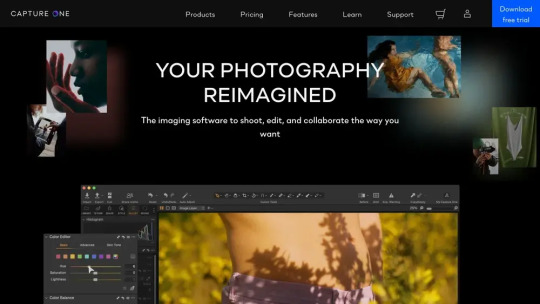
Selecting a formidable AI photo editor involves considering the breadth of features, end-to-end ease, and ability to produce quality outputs – ensuring both casual users and professional photographers can make their images truly stand out. As technology continues to evolve, these tools will undoubtedly lead the charge in redefining visual creation.
For more blogs like this: thenextaitool.com/blog
0 notes
Text
xAI Unveils Grok API
Discover how Grok APIs by xAI revolutionize AI development with free credits and advanced capabilities for all developers.

A great moment for developers everywhere has arrived, as xAI announces the public beta release of their Grok foundation models via a new API. This new platform, built with developers' needs in mind, makes it easier than ever to access and work with Grok's advanced capabilities. The excitement is building as xAI opens up their API today, welcoming developers to try it out and build innovative solutions through a public beta program running until the end of 2024.
Kickstarting Innovation with Free Credits
To encourage widespread participation, xAI is offering $25 worth of free API credits per month to all developers. These credits provide an enticing opportunity for everyone to experiment and build with Grok. Additionally, any prepaid credit purchases already made will come with equivalent free credits monthly for the rest of the year, amplifying the incentives for early adopters.
Getting Started with Grok
Starting is as easy as setting up an account at console xAI. With the promise of a robust framework and versatile tools at developers' fingertips, there's an air of anticipation surrounding what creative solutions will emerge from this initial wave of exploration and deployment.
A Glimpse Into Grok Models
xAI introduces Grok-beta, a developmental model featuring a 128,000-token context length with function calling and system prompts support, while also announcing a multi-modal version coming next week that will expand capabilities to include image processing, appealing to various industries seeking advanced AI solutions.
Explore More with Comprehensive Documentation
The launch of xAI's Grok API represents a significant advancement in AI development, offering developers free monthly credits, extensive token capacity, and seamless platform compatibility. With comprehensive documentation and upcoming multi-modal features, Grok positions itself as a powerful platform for the next generation of AI innovation.
Sign up at here console.x.ai
For more news like this: thenextaitool.com/news
0 notes
Text
Introducing ChatGPT Search
Discover ChatGPT's new search feature that blends conversation with real-time data for seamless, precise information access.
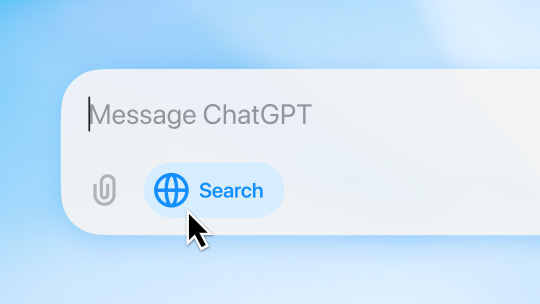
ChatGPT just took a huge step forward. It's mixing conversation with live data, all in one place. Now with its new search feature, you can get precise answers and relevant links without leaving the chat. This makes it super handy for both quick questions and in-depth info needs.
Before, if you wanted to chat and search, you'd have to hop between ChatGPT and your browser. Whether it's checking game scores or the stock market, you'd lose your chatting groove. But not anymore. ChatGPT's got you covered with live updates right in the chat. Cool, right?
Here's how it works:
It kicks in automatically when a question needs outside info. Or, you can manually activate it with a web search icon.
Available on chatgpt.com, mobile, and desktop apps.
Who can use it? Right now, it's for ChatGPT Plus, Team, and SearchGPT waitlist members. But don't worry, it'll soon roll out to everyone!
Why do this? The goal is simple: make it easier for you to get top-notch info without wading through endless search results. ChatGPT's search turns your chats into a treasure trove of web-based answers. Your questions stay in the flow, and the AI fetches what you need. Like magic.
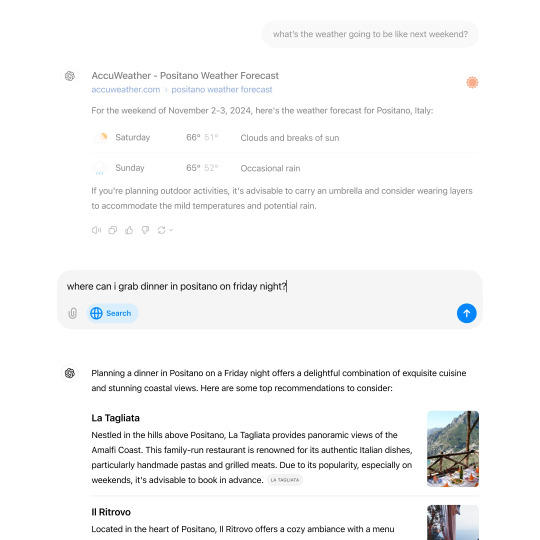
This feature is powered by big names in news and data. So you get the latest weather or financial updates, all from trusted sources. Pam Wasserstein from Vox Media thinks it's a great way to keep quality journalism front and center.
And there's more! Links are embedded right in the chat. So if you want to dive deeper, it's just a click away. Louis Dreyfus from Le Monde sees this as a game-changer for how we access info.
For publishers, this opens new doors. Mathias Sanchez from Axel Springer SE sees potential for AI and journalism to shake up the media world. Big players like the Associated Press and Financial Times are onboard too.
Powered by the fancy GPT-4o framework, the search feature is always learning and getting better. They're focusing on making this feature more useful for areas like shopping and travel.
In short, ChatGPT’s combining chat with search in a big way. It’s all about giving you the best experience and keeping up with how we use tech today.
Future plans include improving search capabilities, especially in shopping and travel, utilizing OpenAI o1 series for deeper research, and extending the feature to Advanced Voice, canvas, and all user.
For more news like this: thenextaitool.com/news
0 notes
Text
The Rise of Intelligent AI Agents
Discover how AI agents are set to revolutionize tech and business, offering smarter assistance in our daily and work lives.

As we welcome the dawn of 2025, a new era is upon us—an era dominated by the rise of AI agents, poised to transform our interaction with technology. Picture a world where our digital assistants not only perform tasks optimally but do so with a level of independence and intuition that mirrors human capabilities. This vision is fast becoming reality as titans of technology, including OpenAI, Anthropic, and Microsoft, push the boundaries of artificial intelligence to make this year the most significant yet in terms of AI advancements.

OpenAI's upcoming AI agents, set for release next year, mark a major step towards Artificial General Intelligence (AGI). Unveiled at OpenAI DevDay, these agents shift from passive responders to autonomous performers, capable of complex tasks like independently ordering goods over the phone. This development aligns with the five-stage AGI roadmap, moving us from current logic-based assistance to true autonomy. The potential impact on productivity is significant, reducing traditional workflows from days to hours and transforming efficiency across industries.

Companies like Anthropic are also at the forefront, fine-tuning AI's handling of complex coding tasks. Their Claude 3.5 Sonnet, an updated AI model, showcases enhancements in 'agentic' coding capabilities, marking improvements across software engineering skills. They have pioneered the concept of AI utilizing computers just like humans, further underscoring the trend toward AI-led automation of multi-step processes, decision-making, and workflow management.
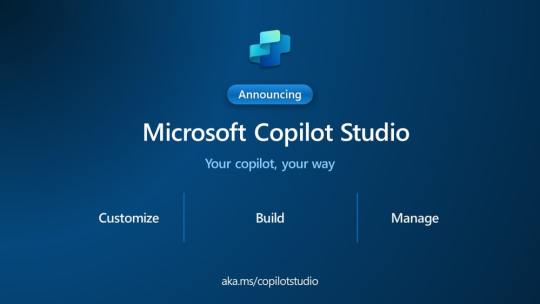
Meanwhile, Microsoft's introduction of Copilot Studio unveils a new frontier for enterprise efficiency. Through autonomous agents tailored for sales, finance, and customer service, businesses can anticipate enhanced productivity. This advancement reflects a paradigm shift wherein AI systems not only assist in basic tasks but can potentially operate with an autonomy reminiscent of human-driven business operations. By performing tasks such as managing supplier performance or expediting client onboarding, AI agents are set to enhance operational dynamics significantly.
Safety and ethics remain central to AI’s evolution, with developers prioritizing rigorous safety protocols and transparency to prevent misuse. As AI agents advance, it’s crucial they clearly convey their non-human nature to avoid ethical pitfalls. By 2025, these agents are expected to transition from supportive aides to integrated tools in daily life, unlocking new levels of efficiency and innovation. This shift calls for responsible management to ensure AI aligns with human values, enhancing rather than replacing human capabilities, and paving the way for a future where AI serves as a trusted partner in innovation.
For more blogs like this: thenextaitool.com/blog
0 notes
Text
Anthropic Unveils Upgraded Claude 3.5 Sonnet and New Claude 3.5 Haiku Models
Explore Anthropic's Claude 3.5 models enhancing coding and AI-computer interactions, with a focus on speed, safety, and innovation.

Anthropic is shaking things up with their latest AI models, Claude 3.5 Sonnet and Claude 3.5 Haiku. They’ve made some big strides in coding performance and how AI interacts with computers. Here's what's new: Claude 3.5 Sonnet is all about better coding. It's like the brainy child of its older model, Claude 3 Opus, but just as cost-friendly and speedy. Perfect for those wanting sophisticated solutions without the extra price tag.
Claude 3.5 Haiku gives you similar power, but in a more compact form. Think fast and affordable, perfect for quick, efficient AI tasks. What's really got people talking? Anthropic is testing a new public beta feature for computer interaction. Imagine AI using a computer like you do—clicking, typing, the whole deal. It's still early days. But already, companies like Asana and Canva are on board to see how it works for complex tasks. Why does this matter? It's because the Claude 3.5 Sonnet is kicking up a storm in software engineering. Its coding skills improved from 33.4% to 49.0% on SWE-bench Verified. That's like upgrading from a bicycle to a motorbike. And it's not just the numbers. GitLab and others love how fast it is, without slowing down your work. It's making heads turn in big places.

They're also serious about safety. Before launching, Anthropic partnered with US and UK safety institutes to test everything. They want this tech out there, but safely. What about this new Claude 3.5 Haiku? It's coming soon, focusing on speed and clarity. Initially, it's text-only but will expand to handle images too. This new computer use feature? It's opening a whole new world of AI. Yes, there are hiccups, like when it struggles with scrolling, but it's rapidly improving. Safety is top priority. Anthropic is working on ways to prevent misuse, focusing on keeping things secure. Curious for more? Anthropic shares all the gritty details in their post on how they're tackling this. Keep an eye out. This is just the beginning for Anthropic and their AI journey.
For more news like this: thenextaitool.com/news
0 notes
Text
New Open-Source Video Generation Model Mochi by Genmo
Mochi, Genmo's AI video tool, offers open-source, high-performance, and accessible video-making technology.
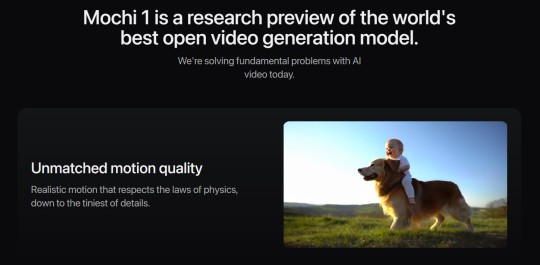
Have you ever heard about the rapid changes in video-making technology? Well, let me introduce you to Mochi, Genmo's latest creation that's all about generating videos. Trust me, it's something special. Mochi's a big deal because it blends top-notch performance with being easy to access. It's perfect for artists, researchers, and developers who want a taste of the latest in AI video tech.
Mochi’s preview model can churn out videos in 480p quality. Not bad, right? And it does this with a pretty straightforward design. The magic happens thanks to Genmo's fancy new 'Asymmetric Diffusion Transformer,' or AsymmDiT for short. This model's huge, with 10 billion parameters. But here's the catch – it's available to everyone! Genmo made it open-source, so folks can tweak it based on their needs and share feedback. Pretty cool if you ask me.
So, what makes Mochi tick? It's efficient. For starters, it uses something called a video VAE (fancy for variational autoencoder). This tech compresses video a whopping 128 times, keeping things smooth without giving up quality. And to keep the visuals sharp, it directs all its brainpower — a single T5-XXL language model — to follow your prompts closely. Sure, there might be a bit of wobble in fast-moving scenes right now, but that should get better soon.
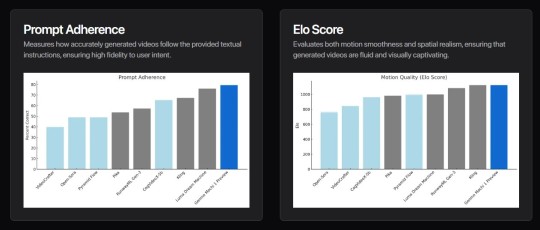
And what's next for Mochi? The team at Genmo isn't stopping. Later this year, they'll roll out Mochi HD, stepping up to 720p videos with even clearer quality. Thanks to the open-source license under Apache 2.0, anyone can jump in, tweak, and enhance it if they've got the skills. So, if you're into video stuff, Mochi is something you might want to check out at Genmo’s playground. Who knows? It could be the next big thing for video lovers like us.
For more news like this: thenextaitool.com/news
0 notes
Text
Microsoft's Copilot Studio Brings Autonomous Agents
Microsoft's AI assistant "Copilot Studio" creates agents for business efficiency, boosting performance across sectors.
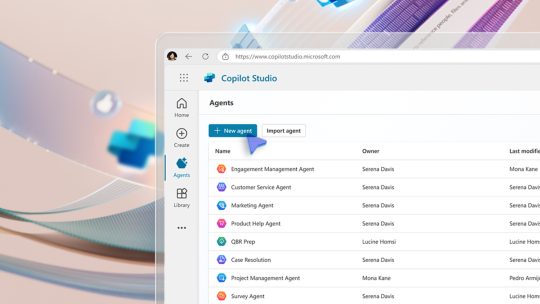
Microsoft is bringing more power to the technology world. They've introduced the AI assistant "Copilot Studio," which allows you to create autonomous agents. Soon, you'll be able to preview these agents. These agents will enhance capabilities in sales, service, finance, and the supply chain. They can handle everything from quick replies to operating independently.
It seems different sectors are already utilizing these agents in their businesses. Take Pets at Home in the UK, for example. They've developed an agent to streamline their team functions, resulting in significant annual savings. McKinsey & Company is using an agent to expedite client onboarding, cutting lead time by 90%. Thomson Reuters has an agent that has reduced the time required for legal checks by half, boosting efficiency. Honeywell reports that it's like adding 187 full-time workers to the team.

There's more! Microsoft is introducing ten new agents for Dynamics 365. These will integrate into various business areas, such as:
- Sales: The Sales Qualification Agent helps boost sales by prioritizing leads. - Supply Chain: The Supplier Communications Agent manages supplier performance and keeps operations running smoothly. - Customer Service: The Customer Intent and Customer Knowledge Management Agents help businesses excel when interacting with customers.
Safety and privacy are critical here. Microsoft ensures their agents adhere to strict data rules, emphasizing security, privacy, and responsible AI use.
Even Microsoft is seeing the benefits of Copilot. They've observed significant improvements in various areas—better sales, faster customer issue resolutions, and increased clicks on their website.
Looking ahead, the potential of AI solutions seems limitless. As Microsoft and others explore autonomous agents, businesses can find new ways to be productive, efficient, and cost-effective, staying competitive in a rapidly changing market.
For more news like this: thenextaitool.com/news
0 notes